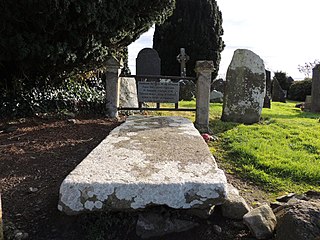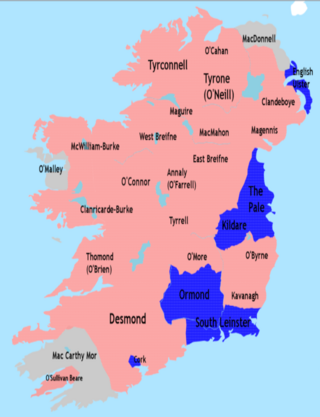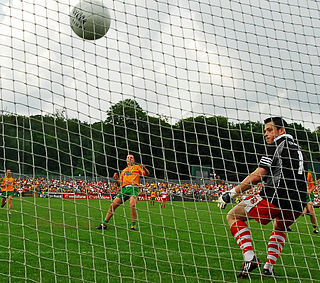This article includes a list of references, related reading, or external links, but its sources remain unclear because it lacks inline citations .(November 2021) |
David Murphy (fl. early 17th century) was an Irish composer and harper.
This article includes a list of references, related reading, or external links, but its sources remain unclear because it lacks inline citations .(November 2021) |
David Murphy (fl. early 17th century) was an Irish composer and harper.
Murphy, a native of County Mayo, is one of two men credited by Captain Francis O'Neill with composing the air, An Tighearna Mhaigheo/Lord Mayo (the other being Thady Ó Cianáin).
O'Neill gives this account of its composition:
"The circumstances which led to its inspiration were as follows: David Murphy undoubtedly a man of genius, who had been taken under the protection of Lord Mayo (Tiobóid na Long Bourke, 1st Viscount Mayo, 1567–1629) through benevolent motives, incurred his patron’s displeasure by some misconduct. Anxious to propitiate his Lordship, Murphy consulted a friend, Capt. Finn, of Boyle, Roscommon. The latter suggested that an ode expressive of his patron’s praise, and his own penitence, would be the most likely to bring about the desired reconciliation."
"The result was in the words of the learned Charles O’Conor, “the birth of one of the finest productions for sentiment and harmony, that ever did honor to any country.”"
"Apprehensive that the most humble advances would not soften his Lordship’s resentment. Murphy concealed himself after nightfall in Lord Mayo’s hall on Christmas Eve, and at an auspicious moment poured forth his very soul in words and music, conjuring him by the birth of the Prince of Peace, to grant him forgiveness in a strain of the finest and most natural pathos that ever distilled from the pen of man. Two stanzas will show the character of his alternating sentiments.
Henry Grattan was an Irish politician and lawyer who campaigned for legislative freedom for the Irish Parliament in the late 18th century from Britain. He was a Member of the Irish Parliament (MP) from 1775 to 1801 and a Member of Parliament (MP) in Westminster from 1805 to 1820. He has been described as a superb orator and a romantic. With generous enthusiasm he demanded that Ireland should be granted its rightful status, that of an independent nation, though he always insisted that Ireland would remain linked to Great Britain by a common crown and by sharing a common political tradition.

Monarchical systems of government have existed in Ireland from ancient times. In most of Ireland, this continued until 1949, when it transitioned to being the Republic of Ireland. Northern Ireland, as part of the United Kingdom, remains under a monarchical system of government.

Edward Bruce, Earl of Carrick, was a younger brother of Robert the Bruce, King of Scots. He supported his brother in the 1306–1314 struggle for the Scottish crown, then pursued his own claims in Ireland. Proclaimed High King of Ireland in 1315 and crowned in 1316, he was eventually defeated and killed by Anglo-Irish forces of the Lordship of Ireland at the Battle of Faughart in County Louth.
Somhairle Buíodh MacDonnell, also spelt as MacDonald, was Gaelic chief, the son of Alexander Carragh MacDonnell, 5th of Dunnyveg, of Dunyvaig Castle, lord of Islay and Cantire, and Catherine, daughter of the Lord of Ardnamurchan, both in Scotland. MacDonnell is best known for establishing the MacDonnell clan in Antrim, Ireland, and resisting the campaign of Shane O'Neill and the English crown to expel the clan from Ireland. Sorley Boy's connection to other Irish Roman Catholic lords was complicated, but also culturally and familiarly strong: for example, he married Mary O'Neill, the daughter of Conn O'Neill. He is also known in English as Somerled and Somerled of the yellow hair.

Lord of the Isles or King of the Isles (Scottish Gaelic: Triath nan Eilean or Rìgh Innse Gall) is a title of Scottish nobility with historical roots that go back beyond the Kingdom of Scotland. It began with Somerled in the 12th century and thereafter the title was held by a series of his descendants, the Norse-Gaelic rulers of the Isle of Man and Argyll and the islands of Scotland in the Middle Ages. They wielded sea-power with fleets of galleys (birlinns). Although they were, at times, nominal vassals of the kings of Norway, Ireland, or Scotland, the island chiefs remained functionally independent for many centuries. Their territory included much of Argyll, the Isles of Arran, Bute, Islay, the Isle of Man, Hebrides, Knoydart, Ardnamurchan, and the Kintyre peninsula. At their height they were the greatest landowners and most powerful lords after the kings of England and Scotland.
Hugh Roe O'Donnell, also known as Red Hugh O'Donnell, was a sixteenth-century leader of the Gaelic nobility of Ireland. He became Chief of the Name of Clan O'Donnell and Lord of Tyrconnell in 1593, following a lengthy succession dispute within the derbhfine of the O'Donnell dynasty, and after escaping a five-year imprisonment without trial in Dublin Castle. Along with his father-in-law Hugh O'Neill of Tyrone, he led an alliance of Irish clans in the Nine Years' War against the English government in Ireland. Hugh Roe led an Irish army to victory in the Battle of Curlew Pass. After defeat in the Siege of Kinsale, he travelled to Spain to seek support from King Philip III. Unsuccessful, he died in Spain and was succeeded by his younger brother Rory O'Donnell. He is sometimes also known as Aodh Ruadh II or Red Hugh II, especially in his native County Donegal.

The Nine Years' War, sometimes called Tyrone's Rebellion, took place in Ireland from 1593 to 1603. It was fought between an Irish alliance—led mainly by Hugh O'Neill of Tyrone and Hugh Roe O'Donnell of Tyrconnell—against English rule in Ireland, and was a response to the ongoing Tudor conquest of Ireland. The war was fought in all parts of the country, but mainly in the northern province of Ulster. The Irish alliance won some important early victories, such as the Battle of Clontibret (1595) and the Battle of the Yellow Ford (1598), but the English won a victory against the alliance and their Spanish allies in the siege of Kinsale (1601–02). The war ended with the Treaty of Mellifont (1603). Many of the defeated northern lords left Ireland to seek support for a new uprising in the Flight of the Earls (1607), never to return. This marked the end of Gaelic Ireland and led to the Plantation of Ulster.

The Tudor conquestof Ireland took place during the 16th century under the Tudor dynasty, which ruled the Kingdom of England. The Anglo-Normans had conquered swathes of Ireland in the late 12th century, bringing it under English rule. In the 14th century, the effective area of English rule shrank markedly, and from then most of Ireland was held by native Gaelic chiefdoms. Following a failed rebellion by the Earl of Kildare in the 1530s, the English Crown set about restoring its authority. Henry VIII of England was made "King of Ireland" by the Crown of Ireland Act 1542. The conquest involved assimilating the Gaelic nobility by way of "surrender and regrant"; the confiscation and colonization ('plantation') of lands with settlers from Britain; imposing English law and language; banning Catholicism, dissolving the monasteries and making Anglican Protestantism the state religion.

The Bruce campaign was a three-year military campaign in Ireland by Edward Bruce, brother of the Scottish king Robert the Bruce. It lasted from his landing at Larne in 1315 to his defeat and death in 1318 at the Battle of Faughart in County Louth. It was part of the First War of Scottish Independence against England, and the conflict between the Irish and Anglo-Normans.

Clandeboye or Clannaboy was a kingdom of Gaelic Ireland, comprising what is now south County Antrim, north County Down, and the barony of Loughinsholin. The entity was relatively late in appearance and is associated partly with the Gaelic resurgence of the High Middle Ages. The O'Neill Clandeboy who reigned in the territory descended from Hugh Boy O'Neill, a king of Tyrone. His descendants took advantage of the demise of the Earldom of Ulster during the latter 14th century and seized vast portions of territory. Clandeboye's main seats of power were Shane's Castle and Castle Reagh.

Tír Eoghain, also known as Tyrone, was a kingdom and later earldom of Gaelic Ireland, comprising parts of present-day County Tyrone, County Armagh, County Londonderry and County Donegal (Raphoe). The kingdom represented the core homeland of the Cenél nEógain people of the Northern Uí Néill and although they ruled, there were smaller groups of other Gaels in the area. One part of the realm to the north-east broke away and expanded, becoming Clandeboye, ruled by a scion branch of the O'Neill dynasty. In one form or another, Tyrone existed for over a millennium. Its main capital was Dungannon, though kings were inaugurated at Tullyhogue Fort.

The O'Neill dynasty are a lineage of Irish Gaelic origin that held prominent positions and titles in Ireland and elsewhere. As kings of Cenél nEógain, they were historically one of the most prominent family of the Northern Uí Néill, along with the O'Donnell dynasty. Some O'Neills state that their ancestors were kings of Ailech during the Early Middle Ages, as descendants of Niall of the Nine Hostages.

The Letter to Chesterfield was Samuel Johnson's response to what some believed to be Lord Chesterfield's opportunistic endorsement of his A Dictionary of the English Language. Although Chesterfield was patron of the Proposal for the Dictionary, he made no moves to further the progress of the Dictionary until seven years after his original investment into the project. Suddenly, Chesterfield wrote two "puff" pieces to promote the Dictionary, which prompted Johnson to write a letter accusing Chesterfield of only providing help when it was least needed.
Events from the year 1565 in Ireland.

Michael Murphy is an Irish Gaelic footballer who plays as a full forward for Glenswilly and, formerly, for the Donegal county team, which he captained from December 2010 until his retirement from inter-county football in November 2022. His predecessors as Donegal players, such as Manus Boyle, Brendan Devenney and Anthony Molloy, regard Murphy as the county's greatest ever footballer. Outside his county he is often regarded as one of the sport's all-time best players. With more than 500 points, Murphy is Donegal's all-time record scorer and he is also the county's top goalscorer, with a points-per-game average that is higher even than Martin McHugh.

Tibbot na Long Bourke, 1st Viscount Mayo was an Irish peer and parliamentarian. A prominent member of the MacWilliam Burkes of County Mayo, Tibbot was a Member of the Irish House of Commons and was later created the first Viscount Mayo. His successful life followed, and usefully illustrates, the difficult transition for Irish aristocrats from the traditional Gaelic world during the Tudor conquest of Ireland.
Tibbot MacWalter Kittagh Bourke, 21st Mac William Íochtar was the first and last person to hold that title following its restoration. He was inaugurated at Kilmaine by Hugh Roe O'Donnell in December 1595 to secure Mayo for the rebel Irish Alliance during the Nine Years' War. His rule was opposed by many Bourke nobles, most notably by his arch-rival, the loyalist chief Tibbot na Long Bourke. The two men fought for supremacy over the MacWilliam Lordship throughout the war and control of the area changed hands on numerous occasions. Following Kittagh's flight to Spain in 1602, the MacWilliam chieftainship was abolished yet again, and Tibbot na Long would thereafter be made Viscount Mayo.

The history of the Bissett family in Ireland can be studied independently from that of the originally identical family in Scotland, because of their unique experience following their arrival in Ulster in the early or mid-13th century. Here, while still remaining involved in Scottish affairs, the Bissetts would establish themselves as the Lords of the Glens of Antrim and quickly become equally, then eventually more involved in the politics of the Irish province, becoming among the most Gaelicised of all the so-called Anglo-Norman families in Ireland. The heads of the leading branch of the family soon adopted the Gaelic lineage style Mac Eoin Bissett, by which they are known in the Irish annals, and which translates as "Son/Descendant of John Byset", after a prominent ancestor born in Scotland. In a number of English and Anglo-Norman sources the same head of the family is referred to as the Baron Bissett, also with variants.
The Battle of Knockavoe (Cnoc-Buidhbh) was fought in 1522 between the O'Donnells, led by Hugh Dubh O'Donnell and Manus O'Donnell, both sons of Sir Hugh Dubh O'Donnell, against the O'Neills, in which the O'Neills and their supporters were surprised and routed. Knockavoe was not a lost pitched battle, rather it was in fact the result of a nighttime surprise attack on the O'Neill camp by the O'Donnells. Knockavoe is the hill just behind Strabane in County Tyrone.